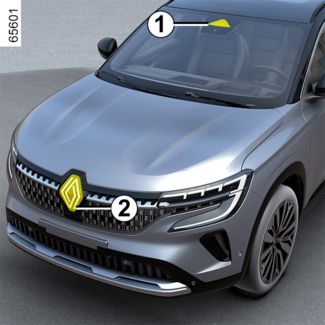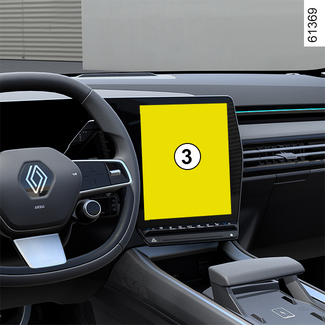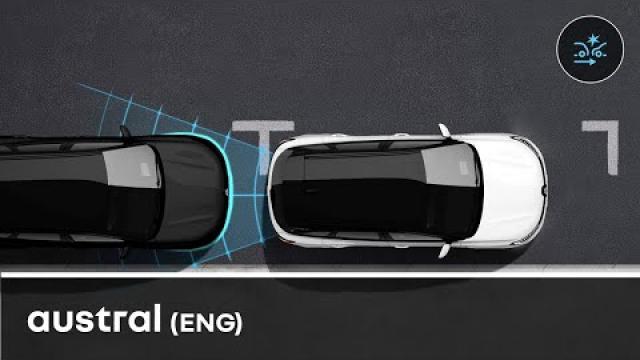Back to the list



Active emergency braking
Active emergency braking

Using information from the camera 1 and the radar 2, the system determines the distance between your vehicle:
- from the vehicle ahead in the same lane;
or
- from any oncoming vehicles in the context of a manoeuvre to change direction;
or
- and vehicles passing perpendicularly;
or
- and stationary vehicles;
or
- surrounding pedestrians and cyclists.
The system informs the driver if there is a risk of head-on collision to enable appropriate
emergency manoeuvres (pressing the brake pedal and/or turning the steering wheel).
Depending on the reactivity of the driver, the system can assist with braking in order
to limit damage or prevent a collision.
The system is otherwise inactive and does not trigger an alert.
WARNING
This function is an additional driving aid.
This function is not under any circumstances intended to replace the due care and
attention of the driver, who should at all times be in control of the vehicle.
Tip
This system can apply maximum braking to the vehicle until it is completely stationary if necessary.
For safety reasons, always wear your seat belt when travelling in your vehicle and
make sure that it is loaded so that no items can be thrown forward and hit the occupants.
Location of the camera 1
Make sure the windscreen is not obscured (by dirt, mud, snow, condensation etc.).
Location of the radar 2
Make sure that the area around the radar is not obscured (by dirt, mud, snow or an
incorrectly fitted number plate), impacted, altered (including paintwork) or hidden.
Operation
When driving, when there is a risk of collision, the system:
- alerts you of a collision risk: the "Detected obstacle" message appears on the instrument panel accompanied by a beep.
Note: if the driver presses the brake pedal and the system still detects a risk of collision,
the braking force may be increased if it is not sufficient to prevent the collision.
- can trigger braking: if the driver does not react to the alert and the collision becomes imminent, the
red warning light
and the "Brake" message are displayed on the instrument panel accompanied by a sound signal.
Note:
- if the driver uses the vehicle controls (steering wheel, pedals, etc.) the system may delay its reaction or not activate;
- if active emergency braking has caused the vehicle to stop, the vehicle is kept stationary for a short time. Beyond this time limit, the driver must keep the vehicle stationary by holding their foot on the brake pedal;
- after the system activates braking, the "Advanced Safety triggered" message will be displayed
Tip
In the event of an emergency manoeuvre, you can stop the braking at any moment by:
- tapping the accelerator pedal;
or
- turning the steering wheel as a collision avoidance manoeuvre.
Tip
Special features of warnings
Depending on the speed, the warning and braking may be activated simultaneously.
Vehicle detection
Detection of vehicles travelling in the same lane
A risk of a collision with the vehicle in front of you in the same lane is detectable
by the system when the vehicle is travelling at a speed over approximately 5 mph (8
km/h).
Detection of oncoming vehicles in the context of a manoeuvre to change direction

When you wish to change direction (e.g. A), oncoming vehicles are detected by the system when:
- your vehicle is travelling at a speed between approximately 5 mph (8 km/h) to 12 mph (20 km/h);
- you have activated the direction indicator light.
Detection of vehicles crossing the lane perpendicularly
Vehicles crossing the lane perpendicularly are detected by the system when:
- your vehicle is travelling at a speed between approximately 12 mph (20 km/h) and 37 mph (60 km/h).
Detection of vehicles stopped in the lane
Stationary vehicles are detected by the system when:
- your vehicle is travelling at a speed between approximately 5 mph (8 km/h) and 50 mph (80 km/h).
Detection of pedestrians and cyclists
Detection of pedestrians and cyclists in the same lane
The system detects pedestrians and cyclists when:
- your vehicle is travelling at a speed between approximately 5 mph (8 km/h) and 53 mph (85 km/h).
Detection of pedestrians and cyclists when changing direction
The system detects pedestrians and cyclists when:
- your vehicle is travelling at a speed between approximately 5 mph (8 km/h) and 12 mph (20 km/h).
Activation/deactivation
Tip
Depending on the vehicle, according to the length of time following the last time
the engine was stopped, the function is reactivated:
- when the vehicle is unlocked;
or
- when a door is opened;
or
- when the engine is restarted.
Activating, deactivating the system from the multimedia screen 3

To activate or deactivate the function, refer to the multimedia instructions.
Select "ON" or "OFF".
Settings
WARNING
For safety reasons, carry out any adjustments while the vehicle is stationary.
Settings from the multimedia screen 3

With the vehicle stationary, to access the function settings from the multimedia screen
3, refer to the multimedia instructions:
"Warning anticipation": adjust the alert sensitivity level. To do this select:
- « Late » ;
- « Standard » ;
- « Early ».
Please refer to the multimedia instructions for more information.
Temporarily not available
If the system detects a temporary fault, the  warning light appears on the instrument panel.
warning light appears on the instrument panel.
The possible causes are:
- the system is temporarily blinded (glare from the sun, dipped beam headlights, bad weather conditions etc.). The system will be operational again when visibility conditions are better;
- the system is temporarily interrupted (e.g. the windscreen, front or rear bumper or logo is obscured by dirt, mud, snow, condensation, etc.) In this case, park the vehicle and switch off the engine. Clean the windscreen, the front bumper or the logo. The next time the engine is started, after around five or ten minutes of driving, the warning light and the message disappear. If this is not the case, this may arise from another cause; contact an approved dealer.
Operating faults
If the system detects a temporary fault, the  warning light appears on the instrument panel. Consult an approved dealer.
warning light appears on the instrument panel. Consult an approved dealer.
Warnings
WARNING
This function is an additional driving aid. This function is not under any circumstances
intended to replace the due care and attention of the driver, who should at all times
be in control of the vehicle. The triggering of this function may be delayed or prevented
when the system detects clear signs of control of the vehicle by the driver (action
on the steering wheel, pedals etc.).
The system cannot be activated:
- the gear control is in Neutral position;
- when the Electronic Stability Program (ESC) has started.
System servicing/repairs
- In the event of an impact, the radar and/or camera alignment may be changed and its operation may consequently be affected. Deactivate the function and consult an authorised dealer.
- Any work in the area where the radar and/or camera is located (repairs, replacements, windscreen modifications, etc.) must be carried out by a qualified professional.
Only an authorised dealer is qualified to service the system.
WARNING
System disturbance
Some conditions can disturb or damage the system's operation, such as:
- a complex environment (metal bridge, tunnel, etc.);
- poor weather conditions (snow, hail, black ice, etc.);
- poor visibility (night, fog, etc.);
- poor contrast between the object (vehicle, pedestrian etc.) and the surrounding area (e.g. pedestrian dressed in white located in a snowy area etc.);
- being dazzled (glaring sun, lights of vehicles travelling in the opposite direction; etc.);
- windscreen obscured (by dirt, ice, snow, condensation etc.);
- ...
In these conditions, the system may not react, may warn the driver or may brake inadvertently.
Limitation of the system operation
- Each time the vehicle is started, the system carries out a calibration according to the vehicle surroundings and may be inactive for approximately two to five minutes;
- The radar and camera areas must be kept clean and free of any modifications to ensure the proper functioning of the system if the conditions described in the "Special cases of oncoming vehicles when changing direction" are met;
- the system may not respond to small vehicles such as motorbikes as effectively as to other vehicles;
- the system may not operate properly when the road surface is slippery (rain, snow, black ice, etc.);
- to ensure correct operation, the system needs to distinguish the complete outline
of the pedestrian. So the system cannot detect:
- pedestrians in the darkness or in poor lighting conditions;
- partially visible pedestrians;
- pedestrians less than approximately 80 cm;
- pedestrians carrying large objects;
- ...
In these conditions, the system may not react, may warn the driver or may brake inadvertently.
WARNING
Deactivating the function
You must deactivate the function if:
- the camera area has been damaged (e.g. on the inside or outside of the windscreen);
- the front of the vehicle was damaged (impact, scratch on the radar, etc.);
- the vehicle is being towed (breakdowns);
- the windscreen is cracked or distorted (do not carry out windscreen repairs in this area; have it changed by an approved dealer);
- you are not driving on a paved road.
In the event of the system behaving abnormally, deactivate it and consult an authorised
dealer.
Halting the function
You can halt the active braking function at any time by tapping the accelerator pedal
or by turning the steering wheel in a collision avoidance manoeuvre.
